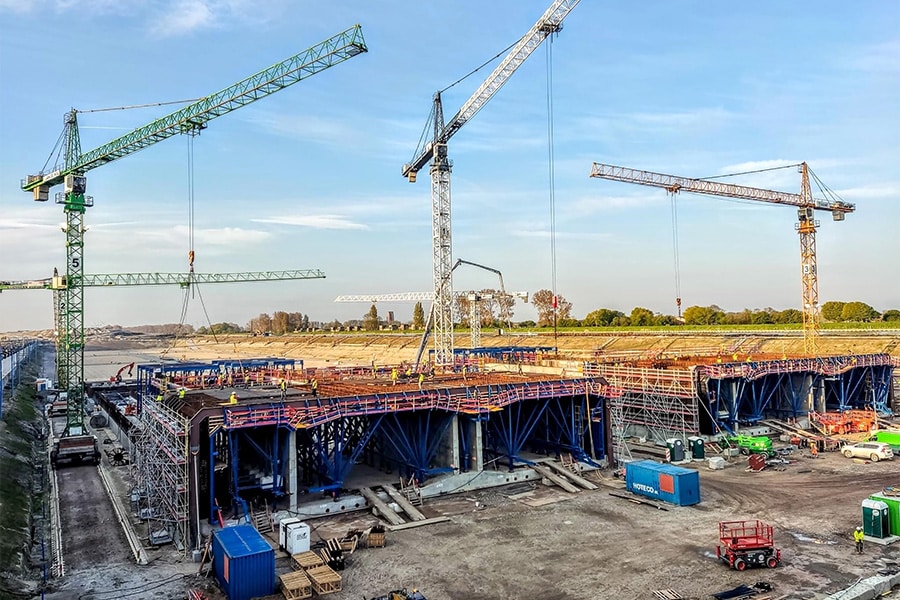
Concrete in road and bridge construction: not gray but green
When people think of concrete, they probably think of gray blocks rather than green and sustainability. Yet concrete is the foundation for the circular economy.
"The central government is working with business, civil society organizations, knowledge institutions and other governments to create a sustainable economy for the future. In this circular economy, no waste exists and raw materials are reused again and again. In the Speech from the Throne, King Willem-Alexander announced that measures are coming up to stimulate this circular economy," opens Taco van den Broek, sector secretary for paving at Betonhuis.
"Part of and condition of the circular economy is that we start building in a different way. There are all kinds of initiatives working towards this. Minister Olongren of the Interior and Kingdom Relations, for example, sent a parliamentary letter about the intended implementation of circular construction in regulations. In it she addressed, among other things, stricter requirements when it comes to the Environmental Performance of Buildings (MPG); this indicates the environmental impact of the materials used in a building."
Building value model for circular design process
Rijkswaterstaat and NEN have established Platform CB'23 with the aim of drawing up national, construction sector-wide agreements on circular construction before 2023. The Implementation Team Circular Design of the Concrete Agreement presented the Building Value Model, which allows all chain partners to easily participate in the circular design process from the design phase in order to achieve a truly circular building.
Concrete paving for proper water management
"Concrete consists of sand and gravel, water and a binder. The Romans already used it to make aqueducts, roads and buildings like the Colosseum and Pantheon. It is also the most widely used building material in our world today. And for good reason. Concrete is a strong, robust and fire-resistant material. It offers architectural freedom of form and color variation and can be easily processed. This creates solutions for modern, safe and sustainable buildings, roads and structures. The discussion currently being held is about switching from asphalt to durable concrete. Betonhuis Bestrating is of the opinion that the Netherlands BV must take this up, to cope with the increasing flooding combined with drought. Concrete allows for sustainable paving, with water infiltrating instead of flowing away. Paving with concrete means being able to dose and let water through."

Circular construction with concrete
Building with concrete fits perfectly into a circular economy. The strongest environmental advantage of concrete is undoubtedly its very long and low-maintenance lifespan. And if a concrete building component does have to be demolished, the material is often repurposed. Concrete overpasses and bridges can be built circularly. In case of demolition, 100% of the concrete debris is reused; as concrete granulate in road foundations or as aggregate in new concrete. The raw materials of concrete are natural and mostly available locally, or within a reasonable distance. Sand, for example, generally comes from the hinterland of rivers such as the Meuse and Rhine. Gravel, too, is an outlet material from rivers. After proximity of raw materials keeps the production chain short, without large transport distances. Concrete is not dependent on raw materials becoming scarce globally or dependent on the fluctuating price of crude oil.
Sustainable paving
An example of what can be done with circular construction is sustainable paving. Concrete is widely used as a paving material. Van den Broek: "We regularly have to deal with heavy showers. Paved surfaces cannot absorb them. Permeable or water-permeable concrete pavers offer a solution. This is open paving, where (rain) water is given room to infiltrate the soil. This open structure can be achieved, for example, by having extra-wide joints between the bricks, or by having an opening on the side or in the middle of the brick, or by a porous concrete composition. Another solution is to use grass concrete tiles. These openings between or in these tiles are filled with soil, for example, so that grass can grow in them."
Opportunities
The members of Concrete House Paving are happy to think along with you about the possibilities. Because they consider it important to offer consistent quality, their processes are checked by an external body against an assessment guideline. In this way, clients (such as municipalities) can be sure that they are purchasing sustainable, green concrete products that have lost nothing of their quality. Want to know more? Check out concretehouse.co.uk/paving.



